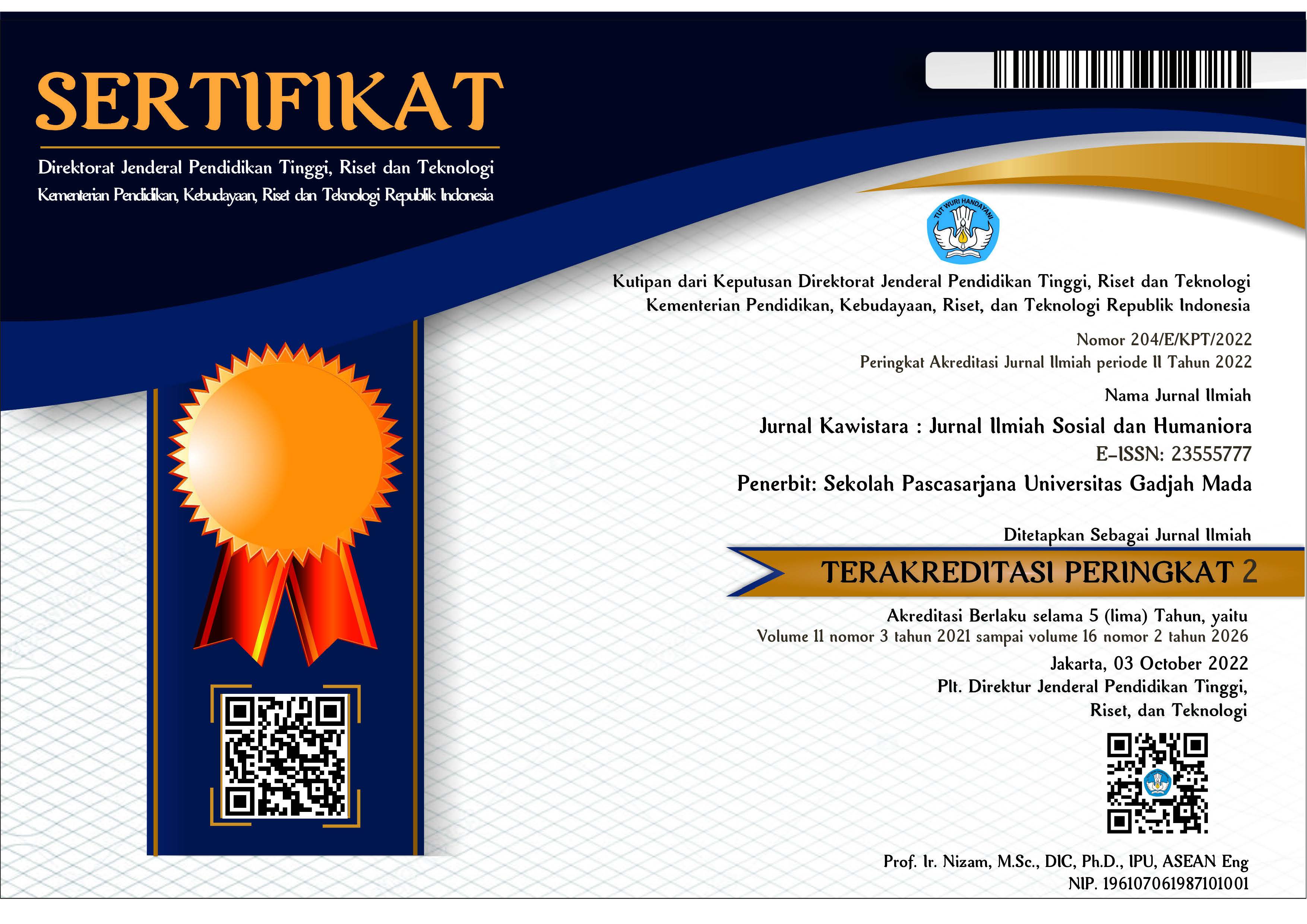CERITA TENTANG PANGAN DAN PAKAN DI DAERAH KODI, SUMBA BARAT DAYA
Wisma Nugraha Christianto(1*)
(1) Gadjah Mada University
(*) Corresponding Author
Abstract
Beginning with the question of why the people of Sumba, especially in Kodi, Southwest Sumba Regency, East Nusa Tenggara Province, feel ‘embarrassed’ to tell the outsiders that they still consume tubers as a staple food, this paper unfolds the story of food and fodder based on the recollection of the community. They eat rice mixed with corn every day and find such food tasty and fulfilling. They solely eat rice during important ritual ceremonies (wedding, funeral, and other traditional rituals). Eating steamed or roasted tubers, accompanied by coffee or sweet tea, has been their morning or afternoon habit while engaging in a conversation with family members. However, tubers become staple food during the hunger season. The data were collected using Participatory Research (RAP) method, or also known as the Action Research. The RAP method also offers ‘learning by doing’ technique that focuses on dialogues between researchers and community members or groups of people to bring together knowledge, experience, and ideas to obtain the desired results and devise future actions. The stories were recorded and documented and later combined with the results of the literature study. The records of the stories were transcribed and then analyzed using the Intertextual method. Rice is a symbol of prosperity and civilization, making it an important food in the ritual sphere in Kodi. However, due to the condition of nature and the persistent drought and water scarcity, rice production becomes highly dependent on rain. The government programs have not been able to solve water management issues in the region.
Keywords
Full Text:
PDFReferences
Bourdieu, Pierre. (1977). Outline of A Theory of Practice. Diterjemahkan oleh Richard Nice. Great Britain: Cambridge University Press.
Culler, Jonathan. (1975). Structuralist Poetics: Structuralism, Linguistics, and The Study of Literature. New York: Cornel university Press.
Dewi, Ni Putu Ayu Krisna. (2016). “Paralelisme Semantik Tuturan Ritual Berladang Dalam Guyub Tuutur Kodi”, Jurnal Aksara, 28 (2): 241-252.
Gelpke, J.H.F. (1986) “Budidaya Padi Di Jawa: Sumbangan Pada Ilmu-Ilmu Bahasa, Daerah, Dan Penduduk Hindia Belanda”, dalam Sajogyo dan William L. Collier (Eds.), Budidaya Padi Di Jawa. Jakarta: Yayasan Obor Indonesia dan P.T. Penerbit Gramedia. Hal 1-98.
Hoskin, Janet. (1996). The Play of Time. Kodi Perspectives on Calendars, History, and exchange. Berkeley, Los Angeles, London: University of California Press.
Jayanti, I G. N. (2015). “Bentuk-Bentuk Ritual Adat di Kampung Umbu Koba (Sebuah Tinjauan Antropologi Relegi)”. Jnana Budaya: Media Informasi Sejarah, Sosial, dan Budaya, 20 (2): 217-228.
Kaleka, Rofinus D. (2018). Minye Mbiri Kyoni. Kompasiana. Diakses pada tanggal 18 September 2018. Dapat diakses di https://www.kompasiana.com/rofinusdkaleka/5a4a3379f33441cbe7cf5f2/minye-mbiri-kyoni?page=all).
Mau, Yosep Seran. (2017). “Pengembangan Pare Wangi Sebagai Komoditi Unggulan Lahan Kering Di Sumba Barat Daya. Policy Brief, No. 2. CoE ALRIC.
Ong, Walter J. (1982). Orality and Literacy. London and New York: Routledge.
Orinbao, P. Sareng. (1992). Tata Berladang Tradisonal Dan Pertanian Rasional Suku-Bangsa Lio. Ledalero, Nita, Flores: Seminari Tinggi St. Paulus.
Pemerintah Provinsi Nusa Tenggara Timur, Dewan Ketahanan Pangan Kementerian Pertanian. (2010). Peta Ketahanan dan Kerentanan Pangan Nusa Tenggara Timur 2010. Pemerintah Provinsi Nusa Tenggara Timur, Dewan Ketahanan Pangan, Kementerian Pertanian.
Prabowo, Eko. (2014). “Karakter Fisiologi Padi Gogo Lokal Asal Kabupaten Sumba Barat Daya Pada Berbagai Kondisi Kekeringan.” Skripsi. Bogor, Departemen Biologi Fakultas Matematika dan Ilmu Pengetahuan Alam, Institut Pertanian Bogor.
Swantz, Marja Liisa. (2008). “Participatory Research as Practice” dalam Reason, Peter and Hilary Bradbury (Eds.), 2008. The Sage Handbook of Action Research: Participative Inquiry and Practice. Halaman 31-45. London: Sage Publication.
Vel, Jacqueline. (2010). Ekonomi-Uma: Penerapan Adat Dalam Dinamika Ekonomi Berbasis Kekerabatan., terjemahan Bahasa Indonesia oleh Myrne Tehubijuluw-Umboh. Jakarta: Penerbit HuMa-Jakarta.
Sumber Wawancara:
Pater Robert Ramone (wawancara tanggal 14,21 Juli 2018). Komunikasi Personal. Pengelola Rumah Budaya Sumba (58 tahun)
Suleman (wawancara tanggal 15, 16 Juli 2018). Komunikasi Pribadi. Warga desa Pero Batang (56 tahun)
Dominggus Radabilla (wawancara tanggal 15, 16 Juli 2018). Komunikasi Personal. Rato Adat Kampung Keretana, Kodi
Herman Gono Ate (wawancara tanggal 17 Juli 2018). Komunikasi Personal. Kepala Dinas Tanaman Pangan, Hortikultura dan Perkebunan, Kabupaten Sumba Barat Daya.
Markus Ranggaede (wawancara tanggal 18 Juli 2018). Komunikasi Personal. Rato Adat Desa Kadoeta, Kodi Utara (75 tahun).
Markus (wawancara tanggal 19 Juli 2018). Komunikasi Personal. Warga Desa Pero Batang, Kampung Toda (Kampung Tradisional: Kodi Bokol, Kabihu Mbali Hangali), Kecamatan Kodi (67 tahun)
Yuliana (wawancara tanggal 20 Juli 2018). Komunikasi Personal. Warga desa Pero Batang (48 tahun)
Paulina (wawancara tanggal 20 Juli 2018). Komunikasi Personal. Warga desa Pero Batang (51 tahun)
Umbu Agustinus (wawancara tanggal 21 Juli). Komunikasi Personal. Sopir Angkutan Umbi-umbian di Pasar Wewewa, Warga Wewewa (34 tahun)
Article Metrics
Refbacks
- There are currently no refbacks.
Copyright (c) 2020 Wisma Nugraha Christianto

This work is licensed under a Creative Commons Attribution-ShareAlike 4.0 International License.
Jurnal Kawistara is published by the Graduate School, Universitas Gadjah Mada.











